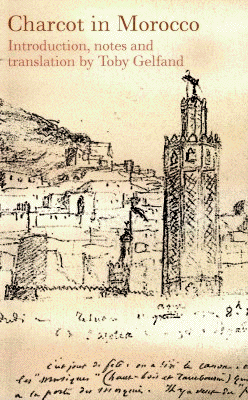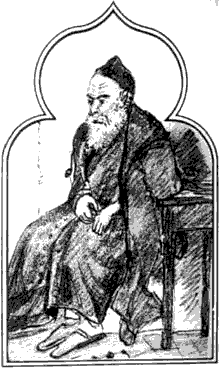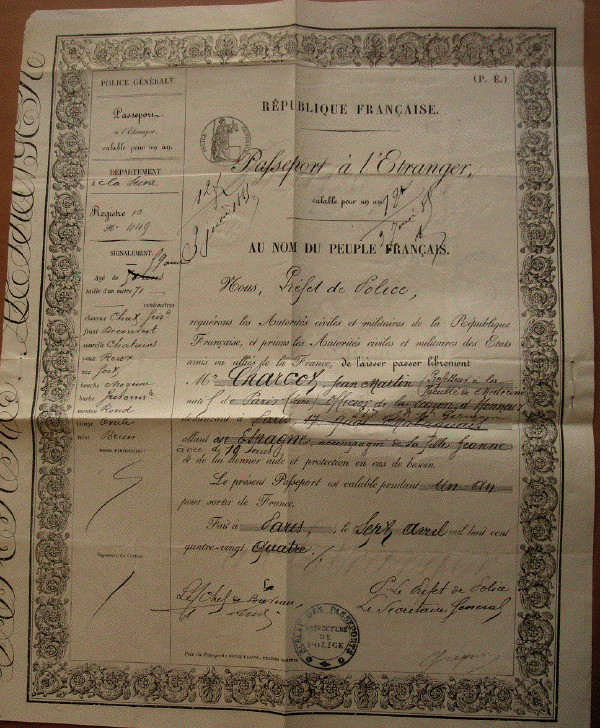-
- Toby Gelfand (Hannah Chair for the History
of Medicine, University of Ottawa) is an
esteemed expert in the history of 19th century
neurology, and in the work of Jean-Martin
Charcot (1825-1893) in particular. In his most
recent book, Charcot in Morocco, he offers the
first English translation of Charcot's
correspondence and notes written during a week's
travels in Morocco in the summer of 1887. This
slim volume provides English speakers access to
little-known material from family archives, and
Gelfand's 30 pages introduction is equally
valuable, linking the importance of Charcot's
pioneering work in neurology, his family life,
and his long-standing love of travel. His first
voyage to Italy in 1853, immediately after he
had defended his doctoral thesis, was indeed
qualified as initiatory by Goetz, Bonduelle and
Gelfand in their 1995 biography Charcot:
Constructing Neurology (1). Throughout his life,
Charcot undertook two or three journeys a year,
often combining professional visits and private
tourism. He frequently journeyed to England and
Spain, but also to Italy, a country that
fascinated him. In addition, he travelled to
Belgium and the Netherlands, as well as
undertaking two journeys to Russia.
-
- With very rare exceptions, Madame Charcot
never wished to take part in these travels. That
is why Charcot regularly wrote to her, at every
stop along his route. Had she accompanied him,
we probably would not have the precious
testimonies of his journeys, of which his
writings from Morocco are one example. In
Morocco Charcot was surrounded by writer
friends, such as Philippe Burty and Paul
Arène, and by physicians, such as Paul
Legendre. Gelfand highlights how Charcot
combined descriptions of the landscape with
details of his daily experiences, including slow
transport, unexpected occurrences, and the
Mediterranean climate. "It is around 3
o'clock; we have let the hottest part of the day
go by. However it remains so hot that I forgo
the niceties. I leave aside cravat and collar; I
wear an unstarched shirt, no jacket, and, for
underclothes, my thin silk which I often use as
a bathrobe. This abandon seems justified by the
consideration that, excepting Jeanne, there are
no women with us... But alas! There will be
women... shortly." (p. 50) Charcot relates
discussions with his companions, including his
daughter Jeanne, of whom he said: "Has
infirmities which are natural of her sex". (pp.
54) As illustrated by his writings, his
curiosity as a tourist provided him with some
surprises, but also with a window onto the
private sphere of those he encountered, which he
observed with his renowned eye as a "visual"
clinician: "A lady of mature years, who appeared
beautiful to me, quickly fled, but not before
showing us her face. That left 4 or 5 Negresses,
who shamelessly stayed where they were.
Moreover, they were very beautiful, their arms
and legs nude, their bodies lightly clothed in a
clear fabric. They certainly do not belong to
the religion whose acolytes cover up." (p. 71)
His little-known sense of humor shone through,
revealing a secret personality which was quite
different from his austere image as the
"Napoleon of neurosis". For example, leaving
Ceuta, Charcot wrote: " They
hoist me up on a kind of chair (cacolet) where I
arrange myself like someone disabled ... which I
am " (p. 51).
-
 -
- Henry Meige noted that "for each of his
voyages, Charcot brought along a sketchbook and
coloured pencils". [...] "The physician
is inseparable from the artist. One is guided by
the other; they help each other mutually".
"Charcot attached the highest value to a gift
he'd received from his friend Burty, an album
containing sketches and notes from a voyage to
Morocco made by the painter Eugène
Delacroix" (2). Gelfand does indeed note that
Charcot had studied the artist's oriental works
before travelling to Morocco, and drew
inspiration from these works for his own
sketches (p. 61). The last stop on his journey
was Tetouan &endash; "a pearl, a jewel" (p. 12)
&endash; where Charcot glimpsed "a genuine Arab
town (...). It's pristine, really pristine." (p.
13) There he met "Arabs of all sorts". (p. 13)
Gelfand's book contains several drawings by
Charcot, notably a magnificent profile of
« Vidal Serfati, prefect of the
Judea ». Charcot made the drawing in
Tetouan and sent it to his wife: "I send
you the sketch of a prefect of the ghetto who
has just brought the patients to us" (figure
14). Later Charcot reworked many drawings,
elaborating on their style and form. They were
preserved for posterity when they appeared in
Iconographie de la Salpêtrière, in
1898 one was published with the caption: "Jewish
patient with Parkinson's disease; Charcot's
sketch of the Tetouan Jew as having been made
during a Moroccan trip" (2).
-
 - Charcot's sketch of a Jewish patient
with Parkinson's disease
- Nouvelle Iconographie de La
Salpêtrière 1898 p
498
-
- Gelfand showcases Charcot's considerable
storytelling abilities, which the physician used
to describe to his wife the exotic colors, odors
and tastes he discovered in the suffocating heat
of August in Morocco. Gelfand also notes that
Charcot expressed anti-Semitic stereotypes that
were common at the time. For example, visiting
the house of a Jewish merchant, Charcot
characterized him as "an old rascal"! (p. 75) As
Gelfand writes: "Charcot believed that his area
of expertise, diseases of the nervous system and
related chronic ailments, provided confirming
evidence of Jewish distinctiveness". (p.
20)
-
- Charcot frequently sent his patients for
thermal treatments to ease their neurological
disturbances, particularly the pain of tabes. He
said of his own travels: "It's my treatment"
(1). About Morocco he commented: "This visit to
Tetouan, with physical exercise outside in
temperatures that average 35° in the shade,
is decidedly advisable... Something to ponder".
(p. 61) Gelfand deserves our thanks for
providing the opportunity to accompany Charcot
during his "therapeutic travels". We conclude as
he does: "Charcot's journal is a series of
finely drawn word pictures, the verbal
counterpart of sketches and the recreational
analogue of the neurologist's working method".
(p. 26)
-
- My enjoyment in reading this book gives me
the opportunity to share with the readers of
"Journal of the History of the Neurosciences" an
unpublished reproduction of the passport used by
Charcot in 1886 to travel to Spain, accompanied
by his son and daughter.
-
- References
- 1. Goetz CG, M Bonduelle and T Gelfand
(1995) Charcot. Constructing neurology. New
York: Oxford University Press.
- 2. Meige H. (1898) Charcot artiste. Nouvelle
Iconographie de la Salpêtrière. 11:
489-516.
-
-
-
- Voir
d'autres portraits, le cabinet de consultation,
le cabinet photographique,
- une
lettre manuscrite de
Charcot
- Une
leçon de Charcot à La
Salpêtrière, tableau de M
Brouillet
- Œuvres
principales de Charcot
- Charcot
JM The topography of the brain Forum
1886
- Charcot
JM Magnetism and hypnotism Forum
1889
- Hypnotisme
and crime Charcot JM
1890
-
- Les
internes de JM. Charcot
-
- JM
Charcot et une patiente
ataxique
1875 la seule photo connue de
Charcot avec un malade
-
- Croquis
de JM. Charcot par Paul
Richer
-
 -
- le passeport de Charcot en 1884 pour
se rendre en Espagne
- taille 1,71 m !!
|



